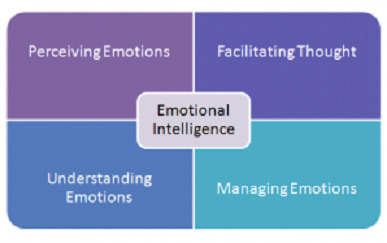The four branch model of emotional intelligence proposed by Salovey and Mayer, that identified four areas of capacities or skills of emotional intelligence: the perception of emotion, the ability reason using emotions, the ability to understand emotion and the ability to manage emotions.
According to Salovey and Mayer, the four branches of their model are, “arranged from more basic psychological processes to higher, more psychologically integrated processes. For example, the lowest level branch concerns the (relatively) simple abilities of perceiving and expressing emotion. In contrast, the highest level branch concerns the conscious, reflective regulation of emotion” (1997).
Salovey and Mayer add that abilities that “emerge relatively early in development are to the left of a given branch; later developing abilities are to the right.” They also say that, “people high in emotional intelligence are expected to progress more quickly through the abilities designated and to master more of them.”
The following diagram depicts different areas of four branch model of emotional intelligence.
More specifically, this four branch model defines emotional intelligence as involving the abilities to:
- Perceive emotions: The nonverbal reception and facial expressions such as happiness, sadness, anger, and fear, were universally recognizable in human beings. The capacity to accurately perceive emotions in the face or voice of others provides a crucial starting point for more advanced understanding of emotions.
- Using emotions to facilitate thoughts: This was the capacity of the emotions to guide the cognitive system and promote thinking and help direct thinking toward matters that are truly important. A number of researchers have suggested that emotions are important for certain kind of creativity to emerge.
- Understanding emotions: Emotions convey its own pattern of possible messages, and actions associated with those messages. This coupled with the capacity to reason about those meanings.
- Managing emotions: Finally, emotions often can be managed. To the extent that it is under self control, a person may want to remain open to emotional signals so long as they are not too painful, and block out those that are overwhelming. In between, within the person’s emotional comfort zone, it becomes possible to regulate and manage one’s own and others’ emotions so as to promote one’s own and others’ personal and social goals. An emotionally intelligent teacher can guide students in a better way.
The first two branches of four branch model of emotional intelligence, Perception, and Facilitation, are termed “experiential EI,” because they relate most closely to feelings. They involve, first, the capacity to perceive emotions in others accurately, and, second, the ability to use emotions to enhance how we think. The third and fourth branches are termed “strategic EI” because they pertain to calculating and planning with information about emotions. The third branch, Understanding Emotions, involves knowing how emotions change, in and of themselves, as well as how they will change people and their behaviors over time. The fourth branch, Emotional Management, focuses on how to integrate logic and emotion for effective decision-making. These four skill areas are related to one another, but they are functionally distinct as well.
Read More:
